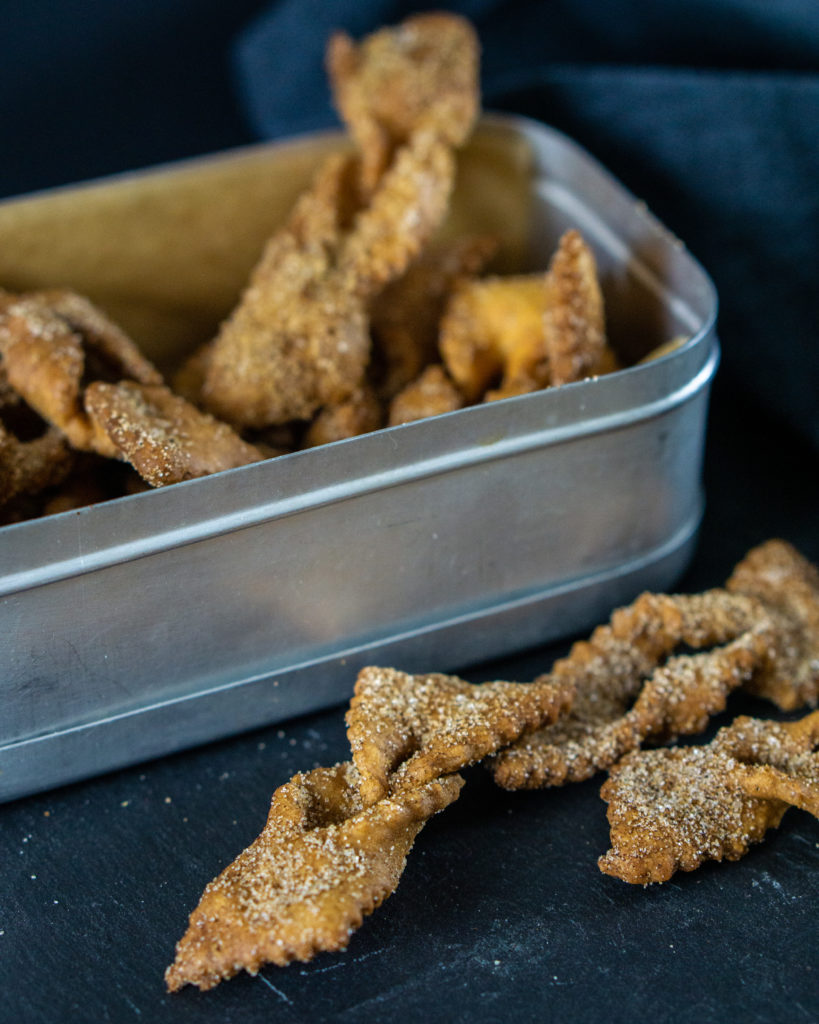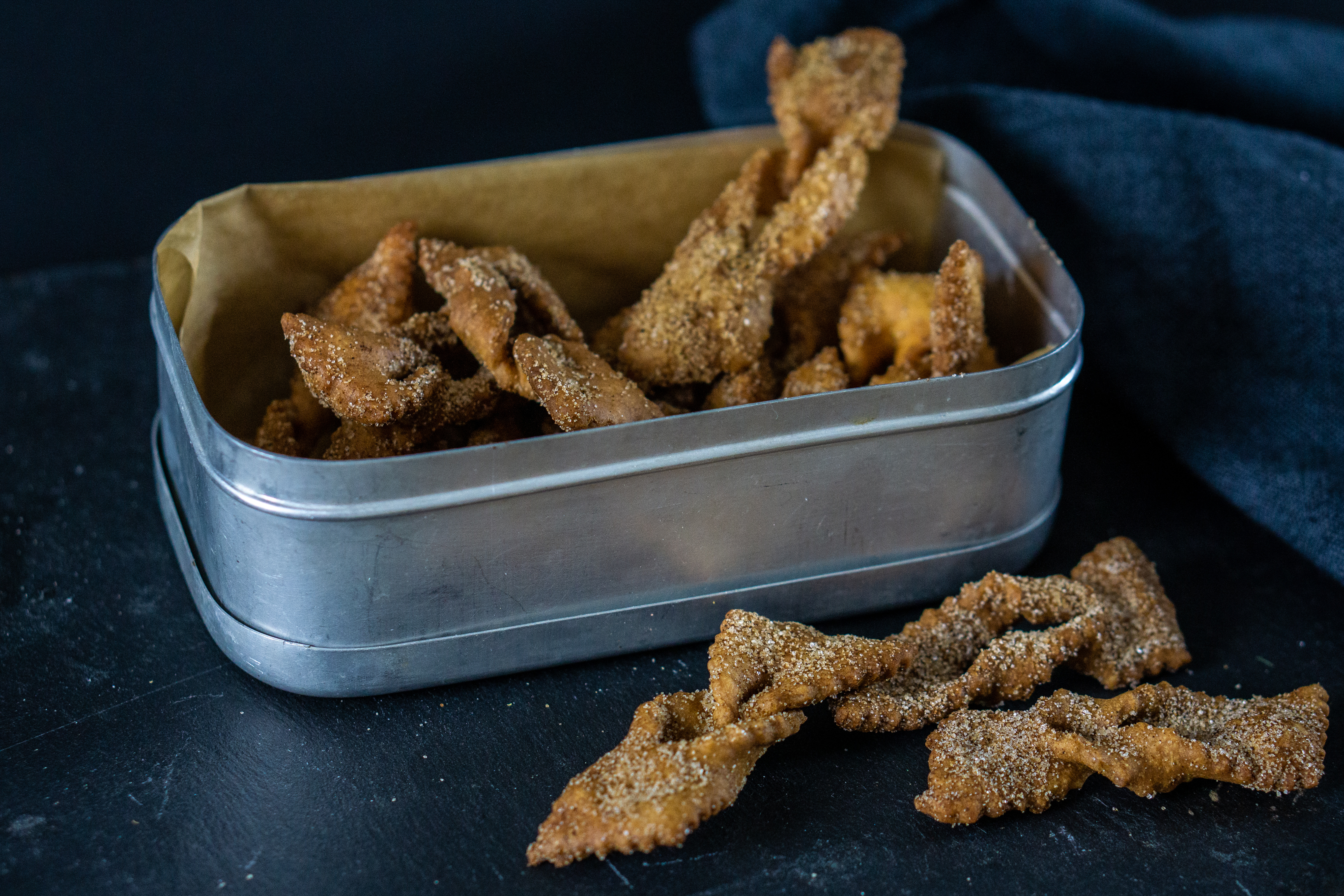Klenäter are Swedish deep-fried Christmas pastries. To be honest, they’ve never been part of my Christmas tradition. Maybe that is because they are from another time—my father recalls them being considered old-fashioned when he was a boy.
The slightly dry texture may not be to everyone’s taste nowadays when there are so many other things on offer. Regardless, it is a traditional Christmas cake with a long history—and if you make this, you’ll feast like a king…
But first, let’s take a look at how to make them, in stop motion:
History
The name, “klenät”, or klenäter in plural, supposedly comes from the Swedish word klenod, which is something precious, such as a piece of jewelry. I’ve also seen the name klenor used for the same type of cake.
Klenäter are old—one of Sweden’s oldest known cookies or cakes. According to baker Carl-Bertil Widell, klenäter came to Southern Sweden at the end of the 15th century. Widell claims that the cake is believed to be German—apparently, they ate something similar already in the 13th century—and that the cake possibly has an Oriental origin.
According to food historian Jan-Öjvind Swahn, the Swedish king Gustav Vasa (1496-1560) enjoyed klenäter. The first reference I’ve found is from Biskopens jultaffel, which contains the notes of Hans Speigelberg, the right-hand man of bishop Hans Brask. Speigelberg notes down what was served at the bishop’s table during the Christmas holidays—and the notes are thought to have been made sometime between 1513 and 1525. At least one of the days during this Christmas, on Christmas Day, the bishop and his party guests had klenäter for as part of their dessert.
So, it is not surprising to find a lot of recipes for klenäter. The oldest recipe in my collection is from Christina Valleria’s cookbook, which most likely predates 1708. She simmers her klenäter in butter and recommends using sugar and nutmeg to reduce the greasy feeling. Recipes in the cookbooks of Cajsa Warg (1755), Gustafva Björklund (1847) and Mathilda Langlet (1884) are all similar. Langlet calls her recipe Fattigmansbakelse (klenät), meaning “poor man’s pastry”, which apparently is the Norweigan name for the pastry. She recommends using as little flour as you get away with and has several suggestions for how to shape the pastries, including “deer antlers” where you cut the pastry dough on one side, like a comb. And, of course, when you remove the pastries from the pot of purified lard, you have to blow on them to remove the oil.

How to make klenäter—Swedish deep-fried Christmas pastries
Remember to keep a large lid close by as you deep-fry, in case of fire. If the oil catches fire, do not pour water on it, but suffocate it. So, just be careful. Makes about 20
25 gr (1/8 cups) butter, room temperature
2 tbsp icing sugar
2 yolks
75 gr (5/8 cups) flour
lemon peel from half a lemon
1 tbsp cognac (or water)
For deep-frying: about 5 dl (2 cups) neutral cooking oil suitable for deep-frying—I used solid coconut fat
For rolling: granulated sugar, ground cinnamon
- In a bowl, stir the butter and sugar until you have a smooth, pale mix.
- Add one yolk and stir it in before adding the second one.
- Add the flour, lemon peel, and cognac, and stir until it forms a dough. Wrap it in clingfilm and chill for at least 2 hours, preferably more.
- Dust a working table with flour and roll out the dough until it is about 5 mm thick (0,2 inches). Using a pastry wheel or a sharp knife, cut the dough into elongated strips, about 10 cm (4 inches) long and 2,5 cm (1 inch) wide. and make a slit in the middle. Turn one of the edges of the pastry through the slit in the middle.
- Prepare a plate or small bowl with a few tablespoons of sugar mixed with a couple of teaspoons of cinnamon.
- Once the pastry is ready, prepare a sturdy pot with enough oil for deep-frying (about half). Make sure to have a large lid handy—one that can completely cover the pot—in case of fire. Heat up the oil until it is 170°C or slightly warmer (340°F). If you don’t have a thermometer, add a piece of white bread. The oil has reached the right temperature when the bread gets brown in about a minute.
- Deep-fry the pastries a few at a time (they swell during cooking) until they are golden, and remove them with a slotted spoon. Sprinkle the sugar and cinnamon mixture on top, while they are still warm.
Suggestions
You can flavor the dough with other things instead of lemon peel, such as cardamom.
Klenäter are best eaten just after they are made—why not serve them with vanilla ice cream, chocolate sauce or both, as a dessert?



0 Comments